Transcription of Effects of temperature dependence of electrical and ...
1 Effects of temperature dependence of electrical and thermal conductivitieson the Joule heating of a one dimensional , ,2 PengZhang,1,a)and Y. of Nuclear Engineering and Radiological Sciences, The University of Michigan, Ann Arbor,Michigan 48109, USA2 Leidos, Inc., Reston, Virginia 20190, USA(Received 4 August 2016; accepted 20 September 2016; published online 5 October 2016)We examine the Effects of temperature dependence of the electrical and thermal conductivities onJoule heating of a one-dimensional conductor by solving the coupled non-linear steady state electri-cal and thermal conduction equations. The spatial temperature distribution and the maximum tem-perature and its location within the conductor are evaluated for four cases: (i) constant electricalconductivity and linear temperature dependence of thermal conductivity, (ii) linear temperaturedependence of both electrical and thermal conductivities, (iii) the Wiedemann Franz relation formetals, and (iv) polynomial fits to measured data for carbon nanotube fibers and for copper.
2 For (i)and (ii), it is found that there are conditions under which no steady state solution exists, which mayindicate the possibility of thermal runaway. For (i), analytical solutions are constructed, from whichexplicit expressions for the parameter bounds for the existence of steady state solutions areobtained. The shifting of these bounds due to the introduction of linear temperature dependence ofelectrical conductivity (case (ii)) is studied numerically. These results may provide guidance in thedesign of circuits and devices in which the Effects of coupled thermal and electrical conduction by AIP Publishing.[ ]I. INTRODUCTIONJ oule heating limits the operation of most current carry-ing components and devices, ranging from large high powersystems to nanoscale wires and devices. The coupledthermal- electrical conduction problem is important for wire-array Z-pinches,1power transmission lines,2high powermicrowave devices,3,4and electrical 9In a Z-pinch, in particular, coupled thermal- electrical conduction isresponsible for an electrothermal advancements in nanotechnology, the miniaturi-zation of electronic devices, and the increase in density ofcircuit integration make Joule heating increasingly impor-tant to device performance and lifetime.
3 The growing pack-ing density and the power consumption of very large scaleintegration (VLSI) circuits, in particular, have made thermaleffects one of the most important concerns of VLSI micro-electro-mechanical (MEM) switches, thedurability of the devices is largely limited by Joule heatingat the contacting ,13 Coupled thermal-electricaleffects play important roles in current emission performanceas well as the stability of carbon nanofiber based field 17 There has also been interest in understanding andcontrolling the local temperature increases within electri-cally driven nanoscale wires and metallic stability is one of the key challenges in nanoscaledevices made of novel materials, such as graphene19 21andorganic ,23In electrically pumped nanolasers forchip-scale optical communications, thermal management isof crucial importance to realize room ,25 Available 3D finite element simulation codes may beused to compute the Effects of coupled electrical and thermalconduction with great accuracy.
4 However, the parametricdependences of the solution are difficult to determine fromsuch purely numerical calculations. Here, by using a verysimple 1D model, we aim to provide a better understandingof the underlying physics and the influences of multipleparameters on key properties of the solution, including themaximum temperature and its location in the this paper, we evaluate the Effects of temperaturedependence of the electrical and thermal conductivities onthe Joule heating of a one-dimensional (1D) conductor, bysolving the coupled non-linear steady state electrical andthermal conduction equations. SectionIIprovides the formu-lation of our simple theory. Results and discussions are givenin SectionIII, where we have analyzed four cases: (1) con-stant electrical conductivity and linear temperature depen-dent thermal conductivity, (2) linear temperature dependenceof both electrical and thermal conductivities, (3) theWiedemann Franz (WF) law, and (4) realistic examples forcarbon nanotube fibers (CNFs) and copper.
5 A summary andsuggestions for future research are given in FORMULATIONC onsider a one-dimensional (1D) conductor of lengthL,which is held at temperaturesT1andT2at its ends, andacross which a voltage ofV0is applied. The steady state heatconduction and electrical current continuity equations are,respectively,a)Present Address: Department of electrical and Computer Engineering,Michigan State University, East Lansing, Michigan 48824-1226, mail: by AIP , 135105-1 JOURNAL OF APPLIED PHYSICS120, 135105 (2016) Reuse of AIP Publishing content is subject to the terms at: Download to IP: On: Wed, 05 Oct 201614:25:00ddzjT;z ddzTz rT;z ddzVz 2 0;(1)ddzrT;z ddzVz 0;(2)wherej T;z andr T;z are the temperature -dependentthermal and electrical conductivities, respectively, andV z is the potential,T z is the temperature , andzis the locationalong the 1D conductor. The above equations are solvedwith the following boundary conditions:T z 0 T1;(3a)T z L T2;(3b)/ z 0 0;(3c)/ z L V0:(3d)Combining Eqs.
6 (1),(2),(3c), and(3d), we haveddzjT;z dTdz J2crT;z 0;(4)whereJc rdV=dz constant is the current density in theconductor, which satisfies L0 Jc=r dz simplicity, we introduce the normalizations, z z=L, T T T1 =T0, withT0 T1ifT1 T2, andT0 T2 T1ifT16 T2, V V=V0, j T; z j T;z =j0, r T; z r T;z =r0,a r0V20=j0T0,J0 r0V0=L, andJc Jc=J0. Note that the parameteraincludes the informa-tion about the boundary conditions in Eqs.(3a) (3d).j0andr0are constants to be defined below. Equation(4)becomesdd z jd Td z aJc2 r;(5)whereJc 10d z= r 1, and the boundary conditions (Eqs.(3a)and(3b)) are T z 0 0;(6a) T z 1 0;if T1 T2;1;if T16 T2: (6b)Equations(5)and(6)are solved to give the steady-state solu-tion for the coupled electrical -thermal conduction. In princi-ple, they can be solved numerically for arbitrary temperaturedependence of electrical conductivity r T; z and thermalconductivity j T; z . We focus on several special cases thatcan be of practical importance.
7 Note that ifT1>T2, we haveT0<0, which means that decreasing (increasing) normal-ized temperature Tgives increasing (decreasing) RESULTS AND DISCUSSIONCase 1: Constant electrical conductivity and lineartemperature dependent thermal conductivityFor the special case of constant electrical conductivity,r r0, and linear temperature dependence of thermal con-ductivity,j j0 j0 T T1 ,wehave r 1and j 1 g T, withg j0T0=j0. Note thatgspecifies theslope of the temperature dependence of the thermal conduc-tivity for given boundary temperatures . This case may notsufficiently approximate physical materials in necessarilylarge temperature range, but it can be solved analytically togive a basic understanding of our model. Solving Eqs.(5)and(6)gives T z 1 ffiffiffiffiffiffiffiffiffiffiffiffiffiffiffiffiffiffiffiffiffiffiffiffiffiffiffiffiffiffiag z1 z 1pgif T1 T2; 1 ffiffiffiffiffiffiffiffiffiffiffiffiffiffiffiffiffiffiffiffiffiffiffiffiffiffiffiffiffiffiffiffiffiffiffiffiffiffiffiffiffiffiffiffiffiffiffiffiffiffiffiffiffiffi ga z2 ga g 2 z 1pgif T16 T2:8>>>> <>>>>:(7a,b)For the case ofT1 T2, the temperature distributionalong the 1D conductor from Eq.
8 (7a)is plotted in (a),for various values ofaandg. The maximum temperature Tmaxis Tmax 1 ffiffiffiffiffiffiffiffiffiffiffiffiffif fiffiffiffiffiag=4 1pg;if T1 T2;(8)which always occurs at the center of the 1D conductor zmax 0:5, as seen from (a). However, it is importantto note that the solution in Eq.(7a)becomes unphysicalwhenag< 4. This happens when Tbecomes such that j<0 at some location ( , zmax) of the 1D conductor. Wenote that the absence of a steady state solution may or maynot indicate thermal the case ofT16 T2, the temperature distributionalong the 1D conductor from Eq.(7b)is plotted in (b),for various values ofaandg. WhenT16 T2, the maximumtemperature is found from Eq.(7b)to be Tmax 1 ffiffiffiffiffiffiffiffiffiffiffiffiffiffiffiffiffiffiffiffiffiffiffiffiffiffiffiffiffiffiffiffiffiffiffiffiffiffiffiffiffiffiffiffiffig4a a g 2 2 1sg;ifg 2 <jaj1when T1<T2 ;0when T1>T2 ;otherwise;;ifT16 T28>>>>> <>>>>>:(9a,b)which occurs at zmax a g 2 =awhena g 2 <a2, and at zmax 0 or 1 otherwise.
9 In the last case, the temperaturerange along the 1D conductor is bounded by the temperature at two ends, T1;T2 .135105-2 Appl. , 135105 (2016) Reuse of AIP Publishing content is subject to the terms at: Download to IP: On: Wed, 05 Oct 201614:25:00 ForT16 T2, the conditions for the existence of physicalsteady-state solution in Eq.(7b)area g 2 2g;if 1 g<0;(10a)a g 2 2g;ifg>0:(10b)These conditions are plotted in , where the LowerBound corresponds to (10a) and Bounds to (10b). Withinthe bounds shown (grey area), it is ensured thatj>0 for allpoints along the 1D conductor. Outside the boundaries ofexistence of solution in ,jbecomes imaginary at cer-tain location inz. Possible resulting time-dependent solutionsinclude thermal runaway, oscillation, or non-periodic,bounded variation in time. Our model so far does not answerthe question of which one occurs. These issues will be stud-ied in the future. Note that in the limit ofg!
10 0, the RHS ofEq.(10)becomes g 2 2=g! 4=g, which is the boundfor the case ofT1 T2(2nd sentence after Eq.(8)). This isexpected sinceg!0 indicatesT0 T2 T1!0; thus, thesolution asymptotically approaches that ofT1 T2. In theopposite limit ofg!1, g 2 2=g! g, the boundapproachesa that as long as the electrical conductivity is a con-stant, r 1, the currentJc 1 is independent of thetemperature in the conductor. Thus, the potential profile isalways V z z, for both cases ofT1 T2andT16 T2,asshown in 2: Linear temperature dependence of bothelectrical and thermal conductivitiesIn this case, we assume both electrical and thermal con-ductivities have linear temperature dependence ,r r0 r0 T T1 andj j0 j0 T T1 . After normalization,we have r 1 n Tand j 1 g T, withn r0T0=r0andg j0T0=j0. Since analytical treatments are no longer avail-able, Equations(5)and(6)are solved numerically. In thenumerical calculation, the values ofd Td zj z 0and Jare founditeratively until the correct boundary conditions are in Case 1, there exist bounds beyond which there isno steady state solution for Eqs.

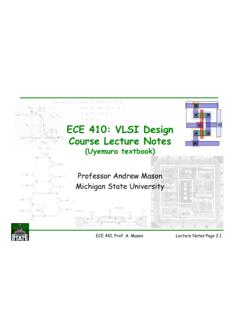


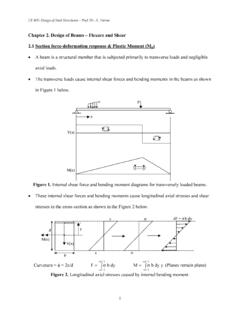

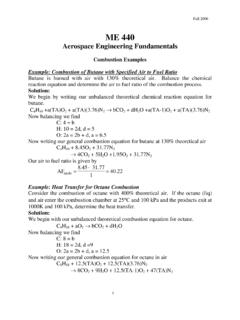


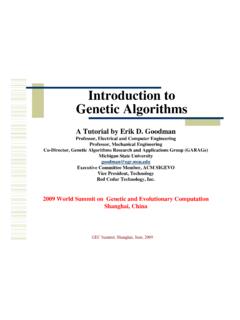
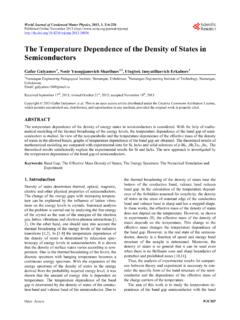



![C = Q/ T = dQ/dT [J/deg] - University of Virginia](/cache/preview/a/f/5/8/1/b/f/3/thumb-af581bf37b8258665c1595c6c7b2f7a3.jpg)




